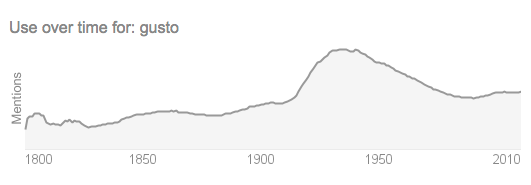 “Gusto” isn’t a word that we hear very often these days. A noun, from the Italian word “gusto”, meaning “taste,” gusto seems to have peaked in popularity at some point in the mid twentieth century. Some of the greatest figures of the 19th and early 20th century: Thoreau, Whitman, Teddy Roosevelt, Kerouac (in the 1950s at least), and Sinatra certainly did things with gusto.
“Gusto” isn’t a word that we hear very often these days. A noun, from the Italian word “gusto”, meaning “taste,” gusto seems to have peaked in popularity at some point in the mid twentieth century. Some of the greatest figures of the 19th and early 20th century: Thoreau, Whitman, Teddy Roosevelt, Kerouac (in the 1950s at least), and Sinatra certainly did things with gusto.
It may be that the culture and upheaval of the 1960s didn’t exactly lend itself to “gusto” and that the generation that grew up in the 70s and 80s was much too sarcastic and cynical for doing things with gusto. In fact, everyone born since the baby boom has been so bombarded with 60s nostalgia that it’s hard to feel like the present is something to be excited about. Some of the most iconic figures since 1960 include people such as Raymond Carver, Bob Dylan, Leonard Cohen, Bukowski, and Kurt Cobain. Few would describe them as having gusto. Where did gusto go?
We think it’s time to bring gusto back — ready or not.
Gusto isn’t safe. The definition of the English word “gusto” is “enjoyment or vigor in doing something.” Beyond the simple definition, gusto generally suggests a passion that’s outside of the bounds of normal.
Dancing with gusto is more than just breaking out a couple half-remembered moves from high school when a Salt-n-Peppa song comes on. Dancing with gusto involves enjoyment mixed with some level of proficiency and lack of concern for what others might think.
Gusto is writing a newsletter about gusto because you know that you can and because you’ll enjoy it, and in spite of the fact that you’ll certainly lose subscribers who are looking for a newsletter that’s directly relevant to their business.
Believe in yourself and have the conviction to embrace whatever you’re doing with a sense of gusto and you’ll probably succeed. If not, you’ll at least be without regrets.
